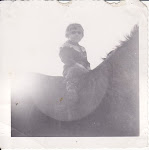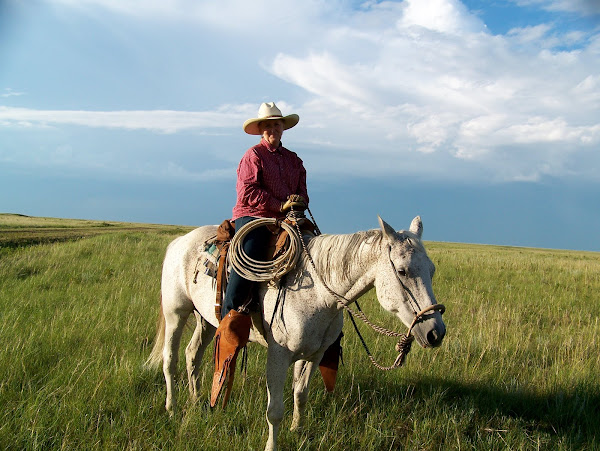Summer is leaves.
seagulls in prairie puddles,
warm blue skies,
and bulls.
Janis had some questions about bulls after my last post and I thought I might just add my answers to this post since I don't have her email to send it to her.
We manage a community pasture where about 50 members lease 40,000 acres from the EID (Eastern Irrigation District, who I think is the largest private landholder in Alberta). They each get to put between 25-50 cow/calf pairs (all cows must come with a calf) out on the lease for 6 months during the summer grazing season. Each member buys where ever he wants and provides a bull for each 25 cows he puts out. We are hired by and answer to a board elected out of those members.
The approximately 1800 cows are divided into 4 herds depending on the type of bull they want to breed to. We have 2 read Angus (one that the bulls come on the 1 of June, the other they turn bulls in on the third week in July or the 1st of August) herds, a Simmental (no blacks), and a Charolais herd. The herds vary in size: the Simmental and the Charolais are the largest herds. The late Red Angus herd is the the smallest. It's pretty standard that there is one bull for every 25 cows in each heard. The largest breeding field is 8 sections the smallest is 2 sections (again a section is a square mile or 640 acres)
Most of the members farm and want to be done calving early so they can concentrate on farming when they need to. Cattlemen here, ranchers, don't usually turn bulls into their cows as early because they don't want to calve in the cold winter weather early in the year, here in Alberta.
Bulls can come here as yearlings (I think they should be 2 year olds when they come but it's not up to me) and they can come back until they are 6, if they are healthy. Semen test and registration papers (they must be purebreds) are required to be turned in to us for every bull that comes to the lease. They are given Cylence (for flies) and Fusagard (for foot rot) at the hoof trimming day which is usually the same day they are brought out.
The owners drop them off but we are required to round them up (when they are done breeding or injured) and bring them in. My husband is like a bull-houdini and can load most bulls out in the middle of an 8 section (8 square mile) field just by opening the door and encouraging them in. The Charolais, we have been driving (us on horseback) to the North Camp corrals (where we live).
Bulls that get broken penis or stifled and cannot breed are sent home to their owners who often then will sell them immediately at the local auction.
Simmental bulls are the ones I like to deal with the most. They seem very manageable, I'm not sure if it's the breed or how the owners handle them. The Charolais are the least manageable, some of them I'm sure it's because of how they are handled when they are not here.
I think 60 days is too long to have the bulls out (see my blogpost : Time to Go Boys for pictures of why) plus I don't think it's a good management practice but again it is not my call. The cows are preg checked by a vet at their owner's place when the owner choose or chooses not to. We watch to see if there is anything bulling (riding/being riden) and can tell generally how the cows are being covered.
If everything looks fine and then we see a bunch of riding later in the year we know there's a problem, probably with tric (a VD that causes aborted fetuses at around 50 days or so). It hasn't happened here but the neighboring lease had it so we're on the look out for it this year.
Every lease is run a little different but that's how it goes here.












10 comments:
Love your photos, that summer sky is wonderful- just needs some hills on the horizon! ;0)
With that much ground to cover in a working day, do you take two horses out? Or just ride one and change horses every day?
Great pics.I meant to ask if it was a comunity pasture situation you guys were running.
just found you (!) and love love love the header. I absolutley .must. figure out how to change that up. Anyway, that's also an excellent photo of the bull.
Very nice shots and post, It amazes me how seagulls find themselves so far north at times, welcome to Sunday Stills...Ed
Great summer pics.....personally I think Herefords are the easy breed to handle but then I also think it's because we handle them more as calves and yearlings.
Wow that sounds interesting! I'm not sure how one stumbles into a job like that but it sure would be awesome!!! And next time we try to load cows, I'll get your husband to help b/c we have the worst luck and I usually walk away covered in muck!
It took years of learning, and doing without, and going where we thought the Lord wanted us, in order to be able to stumble onto it. Everyone knows cowboys get the pay that doesn't come in an envelope so they are never willing too pay much. But as long as we have a roof, food to eat, and can do what we love that's good enough for us
That sounds interesting and confusing, haha. A lot to keep track of.
Good you enjoy doing it, you certainly are good at it. :)
Thank you for that great explanation. Much appreciated. Every farm is different and yours is extremely different from anything around here. I really enjoy learning about all the different kinds of ranches and farms and I really envy anyone that gets to have a horse as a work partner!
My email address, in case you ever need it is:
TailGaitFarm@aol.com
Now lets see some photos of those handsome Simmental bulls please.
Thank you for that wonderful explanation.
Can't wait to see Simmental bull photos.
Post a Comment